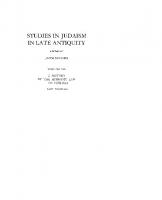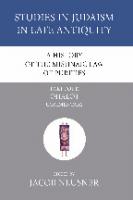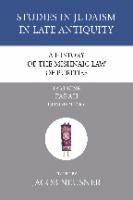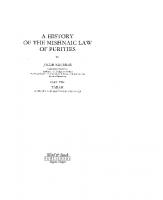A History of the Mishnaic Law of Purities, Part 13: Miqvaot: Commentary (Studies in Judaism in Late Antiquity) 9781597529372, 1597529370
The history of Jews from the period of the Second Temple to the rise of Islam. From 'A History of the Mishnaic Law
151 58 20MB
English Pages 242 [243] Year 2007
CONTENTS
MIQV AOT CHAPTER ONE
MIQV AOT CHAPTER TWO
Recommend Papers

- Author / Uploaded
- Jacob Neusner (editor)
File loading please wait...
Citation preview
STUDIES IN JUDAISM IN LATE ANTIQUITY EDITED BY
JACOB NEUSNER
VOLUME SIX
A HISTORY OF THE MISHNAIC LAW OF PURITIES PART THIRTEEN
A HISTORY OF THE MISHNAIC LAW OF PURITIES PART THIRTEEN
A HISTORY OF THE MISHNAIC LAW OF PURITIES BY
JACOB NEUSNER University Professor Professor of Religious Studies The Ungerleider Distinguished Scholar of Judaic Studies Brown University
PART THIRTEEN
MIQVAOT COMMENTARY
Wipf&Stock PUBLISHERS Eugene,Oregon
Wipf and Stock Publishers 199 W 8th Ave, Suite 3 Eugene, OR 97401 A History of the Mishnaic Law of Purities, Part 13 Miqvaot: Commentary By Neusner, Jacob Copyright©1976 by Neusner, Jacob ISBN 13: 978-1-59752-937-2 ISBN 10: 1-59752-937-0 Publication date 3/19/2007 Previously published by E. J. Brill, 1976
For B(iruchA. Levine 'iN?;).,, 1i~?.il
CONTENTS Preface
IX
Abbreviations and Bibliography
xn
Transliterations .
XVI
Introduction
1
I. Miqvaot Chapter One
11
II. Miqvaot Chapter Two
41
III. Miqvaot Chapter Three
81
IV. Miqvaot Chapter Four
97
V. Miqvaot Chapter Five
112
VI. Miqvaot Chapter Six .
130
VII. Miqvaot Chapter Seven
158
VIII. Miqvaot Chapter Eight
172
IX. Miqvaot Chapter Nine
183
X. Miqvaot Chapter Ten
201
XI. Sifra Shemini IX:1-4 Appendix: Parables among the Pharisees and Early Rabbis . ROBERTM. JOHNSTON, Andrews University Indices for Parts XIII and XIV are at the end of Part XIV
220 224
PREFACE Mishnah-Tosefta Miqvaot presents no more, and no fewer, problems than the tractates that have gone before. It simply is exceedingly difficult, beginning with a series of exegetical problems of considerable complexity and susceptible to no final solution. Here, at the end of ninety-four chapters of Mishnah, we should have hoped that matters would proceed smoothly, but the contrary is the case. The way is as painful and exacting now as it was at the outset. Why go to so much trouble? Perhaps a parable will give the answer. Study of Mishnah-what is ·it like? Once upon a time there were two great islands, far from one another, surrounded by stormy and tempestuous oceans. Between them lies a long and narrow isthmus, stretching for a thousand miles. The isthmus is simply a single mountain range, a parade of ever higher peaks. The mountains meet the sea in a coast of sheer walls of granite. The only way to pass along the isthmus is to climb the mountains, one by one. The one island is shrouded in darkness, the other, full of light. From time to time, though, people living on the dark island get a glimpsemoonbeam, starlight-of illumination. They wonder what other world, a world of light, might lie in that distant world joined to theirs by the stony isthmus. Some set out across the ocean, seeking the illuminated land. A few venture out and return to the dim but secure shore. Others travel further across the ocean, only to perish in mighty whirlpools or in winter-storms. And at home many say to venture forth is hopeless, and anyhow, here is light enough, great light, and many luminaries. But the few continue ·to perceive only darkness, where the many see light. In time a small band determine that the only way between the islands lies across the mountainous isthmus. None knows for sure what is to be seen on that other island. But all know that there is little to be seen on the one on which they are. That little has already been discerned among the shadows. So they set out, one by one, alone, yet in the company of others, and each seeks a way of climbing the first mountain, one up one slope, another up the next, one with ropes, the next with cleats and pick-axes. And all in their different ways, they reach the top, only to discover that beyond lies another, higher mountain, with more precipitous slopes and impassable cliffs. And yet in the distance, they see still a third, and a fourth, and how many after that no one knows. The story has no end, for the story-teller does not know how to describe the distant island.
X
PREFACE
Study of Mishnah is the isthmus, the mountain-range, one mountain after another, with no passage except over the top. Some of the slopes are easy enough; we may cross them walking erect. Others, many others, form sheer cliffs and vertical walls. We climb by inches, with cleats and ropes and pickaxes-and these are the gemarot, rishonim, and aparonim. The journey is long, and not all who start will finish, though there is no turning back. For the goal-the other island-is understanding we now do not have, perception and insight into the nature and structure of the Judaism shaped by the first and second century rabbis for the two millennia thereafter, and for how many more none knows but God. It hardly needs restating that the purpose of the commentary is to provide a dear understanding of the law as I believe it was intended to be understood by the people who made it up. In the present part I lay fresh emphasis on two aspects of original intention: first, the primary meaning of the author of a discrete pericope; but, second, the further understanding of the redactor who put one pericope together with another and thereby imposed a secondary meaning upon both. The secondary, redactional dimension of the exegesis is carefully delineated, where pertinent, apart from the original, received meaning. The issues of immersion-pools raised after the completion of Mishnah-Tosefta, in particular among rishonim, seem to be more profound and philosophically probing than those of our tractate itself. But they are to be investigated in their own context; the great controversies concerning immersion-pools among the rishonim and posqim are possible precisely because Mishnah-Tosefta says nothing to begin with about deeply controverted issues. A peculiarity of translation should be clarified. Mishnah-Tosefta sometimes differentiates between the qal and hifil of TBL. To express that differentiation, I translate TWBL, as dips, meaning, one immerses one's own body, and MTBYL as dunks, meaning, one dunks a utensil. I have tried consistently to place in italics those passages of Mishnah which are cited verbatim, or nearly so, in Tosefta. Brown University paid the cost of typing the manuscript, for which I am grateful. My sometime student and now colleague, Professor Richard S. Sarason, kindly read the manuscript and made many corrections. I owe him much and appreciate his conscientious and careful reading of my manuscript.
PREFACE
XI
The dedication is to a friend, but the reason is not friendship, but scholarship. I mean hereby to express my admiration for, indebtedness to the learning of, Professor Baruch A. Levine. Among Semitists he is one of the very few to read the rabbinic literature both with mastery of the halakhic issues and with sustained interest in their substance. The greater number of Semitists who read the rabbinic literature at all do so for reasons essentially extrinsic to its character and substance and therefore help us very little in our task of exegesis. Levine, by contrast, represents the happy union of Semitic science and rabbinic learning. In this context I pay tribute too to his students, products of the felicitous union effected by the master. One of them, Professor B. Barry Levy, McGill University, taught for two years at Brown University and significantly enriched our curriculum, helping us all to improve important aspects of our exegetical work.
J.N.
ABBREVIATIONS AND BIBLIOGRAPHY Adret AE Ah. Albeck Ar. A.Z. b. B.B. B.M. B.Q. Ber. Bes. Bik. Blackman BY
C Cohn Dan. Danby Dem. Deut. Deutsch Ed. EG EK Eruv. Epstein, Nusa!;i Epstein, Tan. Ex. Greenstone Git. GRA
HA Hag. Hai Hal.
Solomon hen Abraham Adret (c. 1235-c. 1310), Torat habayit shacar hamayim (Jerusalem, 1963). cAqiva Egger, 1761-1837. From reprint of Mishnah, ed. Romm (Vilna, 1887). Ahilot I;I. Albeck, Seder '[ohorot (Jerusalem and Tel Aviv, 1958). cArakhin cAvodah Zarah Bavli, Babylonian Talmud Bava' Batra' Bava' Me~icao Bava' Qamma 0 Berakhot ~ah Bikkurim Philip Blackman, Mishnayoth. VI. Order Taharoth (London, 1955). Bet Yosef. Joseph Karo, Tur Yoreh DeCah. Hi/khot fevilah. Hilkhot macayan vemiqveh. (Repr. Bene Beraq, n.d.). H. Loewe, The Mishnah of the Palestinian Talmud (HaMishnah ca/ pi Ketav-Yad Cambridge) (Jerusalem, 1967). See Hoffmann. Daniel Herbert Danby, The Mishnah (London, 1933). DemaJi Deuteronomy Ch. Y. L. Deutsch, Massakhet MiqvaJot Pereq Risho 0 n 'fohorat Yom 'fov (Brooklyn, 1972-3) I-II. CEduyyot Hiddushe E/iyyahu MiGreiditz. From Mishnah, ed. Romm (Vilna, 1887). CEzrat Kohanim. See Rappaport. CEruvin See Nusal;i See Tan. Exodus Julius H. Greenstone, "Mi¼:weh," Jewish Encyclopedia, 8:588. Gigin Elijah hen Solomon Zalman ("Elijah Gaon" or "Vilna Gaon"), 1720-1797. From Mishnah, ed. Romm (Vilna, 1887), for M., and from standard text of Tosefta Seder Tohorot in Babylonian Talmud, for T. Hon °Ashir. Emanuel 1;:Iaib. Abraham Riqi. In Qevutat Meforshe HaMishnah (Jerusalem, 1962), Vol. VI. I;Iagigah Hai Gaon, Perush ca/ Seder '[ohorot (Berlin, 1856, reprint 1970). I;Iallah
ABBREVIATIONS AND BIBLIOGRAPHY
HD
Hoffmann
Hor. Hui. ID Jastrow
K Katsh
Ke!. Ker. Kil. KM Kotlar Lauterbach Lev. Lieberman, SZ Lieberman, TR
Lieberman, YK Lisowsky M M. MA
Ma. Ma. Er. Maharam Maimonides Maimonides, Rod Heifer Mak. Me. Melamed
XIII
lfasde David. David Pardo, Sefer lf asde David, Part IV. Tosefet Merubah, vehu perush ca/ haTosefta Seder '[ohorot. I. Ke/im, Ahilot. II. Negacim, Parah, Niddah (Jerusalem, 1970). David Hoffmann, Mischnajot. VI. Ordnung Toharot. Punktiert, ins Deutsche iibersetzt, und erk/art (Third edition: Basel, 1969). From M. Negaim 3:7: John Cohn. Horayot l;lullin :>JmreDaCat. Nathan Lieberman. In Qevu1at Meforshe HaMishnah (Jerusalem, 1962) Vol. VI. Marcus Jastrow, A Dictionary of the Targumin, etc. (Reprint N.Y. 1950). Georg Beer, Faksimile-Ausgabe des Mischnacodex Kaufmann A 50 (Reprint: Jerusalem, 1968). Abraham I. Katsh, Ginze Mishnah. One Hundred and Fifty-Nine Fragments from the Cairo Geniza in the SaltykovSchedrin Library in Leningrad (Jerusalem, 1970). Plates 102-115. Kelim Keritot Kila:>yim Kesef Mishnah. Joseph Karo. Co=entary to Maimonides, Mishneh Torah. Published in Venice, 1574-5. Text used: Standard version of Maimonides, Mishneh Torah. D. Kotlar, "Mi~eh," Encyclopaedia Judaica 2: 1534-1544. Jacob Z. Lauterbach, "Parah," Jewish Encyclopedia 9:520. Leviticus See SifLieberman Saul Lieberman, Tosefeth Rishonim. A Commentary. Based on Manuscripts of the Tosefta and Works of the Rishonim and Midrashim and Rare Editions. III. Kelim-Niddah. IV. Mikwaoth-Uktzin (Jerusalem, 1939). Saul Lieberman[n], HaYerusha/mi Kifshufo (Jerusalem, 1934) Part I, Vol. 1. See Tos. Reng. Babylonian Talmud Codex Munich (95). (Reprint: Jerusalem, 1971). Mishnah Mishnah Al;aronah. Ephraim Isaac of Premysla. Published in 1882. From reprint of Mishnah, ed. Ro=. Mataserot Mishnayot Macaseh 'Ereg-Pene Zaqqen. By Yi~l;iaq Yehudah Ye\;tiel Safrin (Levov-Lemberg, 1862). Vol. VI. Meir ben Barukh of Rothenberg (1215-1293). For source, see Sens. Mishnah c;m Perush Rabbenu Moshe ben Maimon. Trans. Joseph David Qappal:i. VI. Seder '[ohorot (Jerusalem, 1968). The Code of Maimonides. Book Ten. The Book of Cleanness, trans. Herbert Danby (New Haven, 1954), pp. 95-146. Makhshirin MeCilah E. Z. Melamed, Hayya};as sheben midrashe halakhah lamishnah velatosefta (Jerusalem, 1967).
XIV
Men. Miq. ML M.Q. M.S. MS MT
N Naz. Nid. Num. Nusap Oh. p Pa Par. PB Pes. PZ QA Qid. QS QZ Rabad Rabad, Sifra Rabin Rappaport
R.H. Rosh Rosh, HM RSS Sanh. Segal
Sens
Shah.
ABBREVIATIONS AND BIBLIOGRAPHY
Menal).ot Miqva~ot Mishneh LaMelekh. Commentary to Maimonides, Mishneh Torah. Judah Rosannes 1657-1727. For source see KM, MoCed Qatan MaCaser Sheni Melekhet Shelomo. Shelomo bar Joshua Adeni, 1567-1625. From reprint of Mishnah, ed. Romm. Mayyim Tahorim. Judah Leh Edel Halevi of Bialystok, 5577 [= 1817]. From reprint of Mishnah in Babylonian Talmud. Mishnah c;m Perush HaRambam. Defus Rishon Napoli [5]· 252 (1492) (Jerusalem, 1970). Nazir Niddah Numbers Y. N. Epstein, Mavo leNusap haMishnah (Jerusalem, Tel Aviv, 19542). Ohalot Shishah Sidre Mishnah. Ketav Yad Parma DeRossi 138 (Jerusalem, 1970). Mishnah Ketav Yad Paris. Paris 328-329 (Jerusalem, 1973). Parah Mishnah Codex Parma "B" De Rossi 497. Seder Teharoth. Introduction by M. Bar Asher (Jerusalem, 1971). Pesal).im Pene Zaqqen. For source, see Ma. Er. Qorban Aharon. Aaron Ibn l;Iayyim (d. 1632), Qorban Aharon, Perush LaSefer Sifra (Dessau, 1749). Qiddushin Qol Sofer. I;Iaim Sofer. From Qevuiat Meforshe HaMishnah (Jerusalem, 1962) Vol. VI. Qol Haramaz. Moshe Zakhuta. From Qevuiat Meforshe HaMishnah (Jerusalem, 1962) Vol. VI. Supercommentary to Maimonides, Code. R. Abraham hen David, Commentary to Sifra. From ed. Weiss. Chaim Rabin, The Zadokite Documents. I. The Admonition. II. The Laws (Oxford, 1958). ~evi Hirsch Hakohen Rappaport, Torat Kohanim, with the commentaries CEzrat Kohanim and Tosefet HaCEzrah (Jeru• salem, 1972). Rosh Hashanah Asher hen Yel).iel, ca. 1250-1327. For source, see Sens. Asher b. Yel).iel, Hilkhot Miqva~ot. For source, see Sens. See Strashun. Sanhedrin M. H; Segal, Mikwaoth. Translated into English with Notes, in I. Epstein, ed., The Babylonian Talmud. Seder Tohoroth (London, 1948: The Soncino Press) pp. 419-462. Samson hen Abraham of Sens, ca. 1150-1230. From reprint of Mishnah Seder Tohorot in Babylonian Talmud, ed. Romm. (Vilna, 1887). Shabbat
ABBREVIATfONS
Shav. Shcv. Sifra Fink.
Sifra Hillel Sifra ed. Weiss Sot. Strashun Suk.
T T. Ta.
T,m.
Telushkin Tern. Ter. Tif. Jacob Toh. Tos. Reng.
Tos. Zuck.
TR T.Y. TYB
TYT TYY
Uqs.
V
Wiener y.
Y.T.
AND BIBLIOGRAPHY
xv
Shavucot SheviCit SifM or Torc1tKohrmim. According to Codex Assemctni LXVI. With a Hebrew Introduction by Louis Finkelstein (N.Y., 1956). Sif rr1, With the Commentary of Hillel b. R. Eliaqim. Ed, by Shaklrna Koleditzky (Jerusalem, 1961). Vol. II. S,f1'J, ed. Isaac Hirsch Weiss (Rcpr. N.Y., 1947). So[ah Samuel ben Joseph Strashun, 179°1-1872. From reprint of Mishnah, ed. Romm. Sukkah Sidre lvf.ishnah. Neziqin, Qodoshim, '[ohorot. Ketav Y,id Yermhalayim, 1336. Ketav Yav beniqud lefi Massoret Teman. (Reprint: Jerusalem, 1970). Introduction by S. Morag. Tosefta Tacanit Y. N. Fpstein, MevoJot LeSifrut HaTcmnaJiin. Mishne1h, Tosefta uMidrashe I-fellakhah. Edited by E. Z. Melamed (Jerusalem and Tel Aviv, 1957). N. Tclushkin, Tohorat M.1nim (3rd


![A History of the Mishnaic Law of Purities, Part 15: Niddah: Commentary (Studies in Judaism in Late Antiquity) [Reprint ed.]
1597529397, 9781597529396](https://ebin.pub/img/200x200/a-history-of-the-mishnaic-law-of-purities-part-15-niddah-commentary-studies-in-judaism-in-late-antiquity-reprintnbsped-1597529397-9781597529396.jpg)
![A History of the Mishnaic Law of Purities, Part 11: Tohorot: Commentary (Studies in Judaism in Late Antiquity) [Reprint ed.]
9781597529358, 1597529354](https://ebin.pub/img/200x200/a-history-of-the-mishnaic-law-of-purities-part-11-tohorot-commentary-studies-in-judaism-in-late-antiquity-reprintnbsped-9781597529358-1597529354.jpg)
![A History of the Mishnaic Law of Purities, Part 15: Niddah: Commentary (Studies in Judaism in Late Antiquity) [Reprint ed.]
9781597529396, 1597529397](https://ebin.pub/img/200x200/a-history-of-the-mishnaic-law-of-purities-part-15-niddah-commentary-studies-in-judaism-in-late-antiquity-reprintnbsped-9781597529396-1597529397.jpg)



![A History of the Mishnaic Law of Purities, Part 3: Kelim: Literary and Historical Problems (Studies in Judaism in Late Antiquity) [Reprint ed.]
9781597529273, 1597529273](https://ebin.pub/img/200x200/a-history-of-the-mishnaic-law-of-purities-part-3-kelim-literary-and-historical-problems-studies-in-judaism-in-late-antiquity-reprintnbsped-9781597529273-1597529273.jpg)
